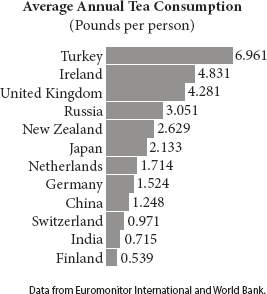PSAT Reading Practice Test 19
Questions 1-10 refer to the following information.
Paired Passages—Tea
Passage 1
Europe was a coffee-drinking continent before it
became a tea-drinking one. Tea was grown in China,
thousands of miles away. The opening of trade routes
with the Far East in the fifteenth and sixteenth cen-
05turies gave Europeans their first taste of tea.
However, it was an unpromising start for the bev-
erage, because shipments arrived stale, and European
tea drinkers miscalculated the steeping time and
measurements. This was a far cry from the Chinese
10preparation techniques, known as a "tea ceremony,"
which had strict steps and called for steeping in
iron pots at precise temperatures and pouring into
porcelain bowls.
China had a monopoly on the tea trade and kept
15their tea cultivation techniques secret. Yet as world-
wide demand grew, tea caught on in Europe. Some
proprietors touted tea as a cure for maladies. Several
European tea companies formed, including the
English East India Company. In 1669, it imported
20143.5 pounds of tea—very little compared to the
32 million pounds that were imported by 1834.
Europeans looked for ways to circumvent China's
monopoly, but their attempts to grow the tea plant
(Latin name Camellia sinensis) failed. Some plants
25perished in transit from the East. But most often the
growing climate wasn't right, not even in the equato-
rial colonies that the British, Dutch, and French
controlled. In 1763, the French Academy of Sciences
gave up, declaring the tea plant unique to China
30and unable to be grown anywhere else. Swedish and
English botanists grew tea in botanical gardens, but
this was not enough to meet demand.
After trial and error with a plant variety dis-
covered in the Assam district of India, the British
35managed to establish a source to meet the growing
demands of British tea drinkers. In May 1838, the
first batch of India-grown tea shipped to London.
The harvest was a mere 350 pounds and arrived in
November. It sold for between 16 and 34 shillings
40per pound. Perfecting production methods took
many years, but ultimately, India became the world's
largest tea-producing country. By the early 1900s,
annual production of India tea exceeded 350 million
pounds. This voluminous source was a major factor
45in tea becoming the staple of European households
that it is today.
Passage 2
In Europe, there's a long tradition of taking
afternoon tea. Tea time, typically four o'clock, means
not just enjoying a beverage, but taking time out to
50gather and socialize. The occasion is not identical
across Europe, though; just about every culture has
its own way of doing things.
In France, for example, black tea is served with
sugar, milk, or lemon and is almost always accom-
55panied by a pastry. Rather than sweet pastries, the
French prefer the savory kind, such as the gougère,
or puff pastry, infused with cheese.
Germans, by contrast, put a layer of slowly melt-
ing candy at the bottom of their teacup and top the
60tea with cream. German tea culture is strongest in
the eastern part of the country, and during the week
tea is served with cookies, while on the weekend or
for special events, cakes are served. The Germans
think of tea as a good cure for headaches and stress.
65Russia also has a unique tea culture, rooted in
the formalism of its aristocratic classes. Loose leaf
black tea is served in a glass held by a podstakannik,
an ornate holder with a handle typically made from
silver or chrome—though sometimes it may be gold-
70plated. Brewed separately, the tea is then diluted
with boiled water and served strong. The strength of
the tea is seen as a measure of the host's hospitality.
Traditionally, tea is taken by the entire family and
served after a large meal with jams and pastries.
75Great Britain has a rich tradition of its own. Prior
to the introduction of tea into Britain, the English
had two main meals, breakfast and a second,
dinner-like meal called "tea," which was held around
noon. However, during the middle of the eighteenth
80century, dinner shifted to an evening meal at a late
hour; it was then called "high tea." That meant the
necessary introduction of an afternoon snack to tide
one over, and "low tea" or "tea time" was introduced
by British royalty. In present-day Britain, your
85afternoon tea might be served with scones and jam,
small sandwiches, and cookies (called "biscuits"),
depending on whether you're in Ireland, England, or
Scotland.
Wherever they are and however they take it,
90Europeans know the value of savoring an afternoon
cup of tea.

Data from Euromonitor International and World Bank.